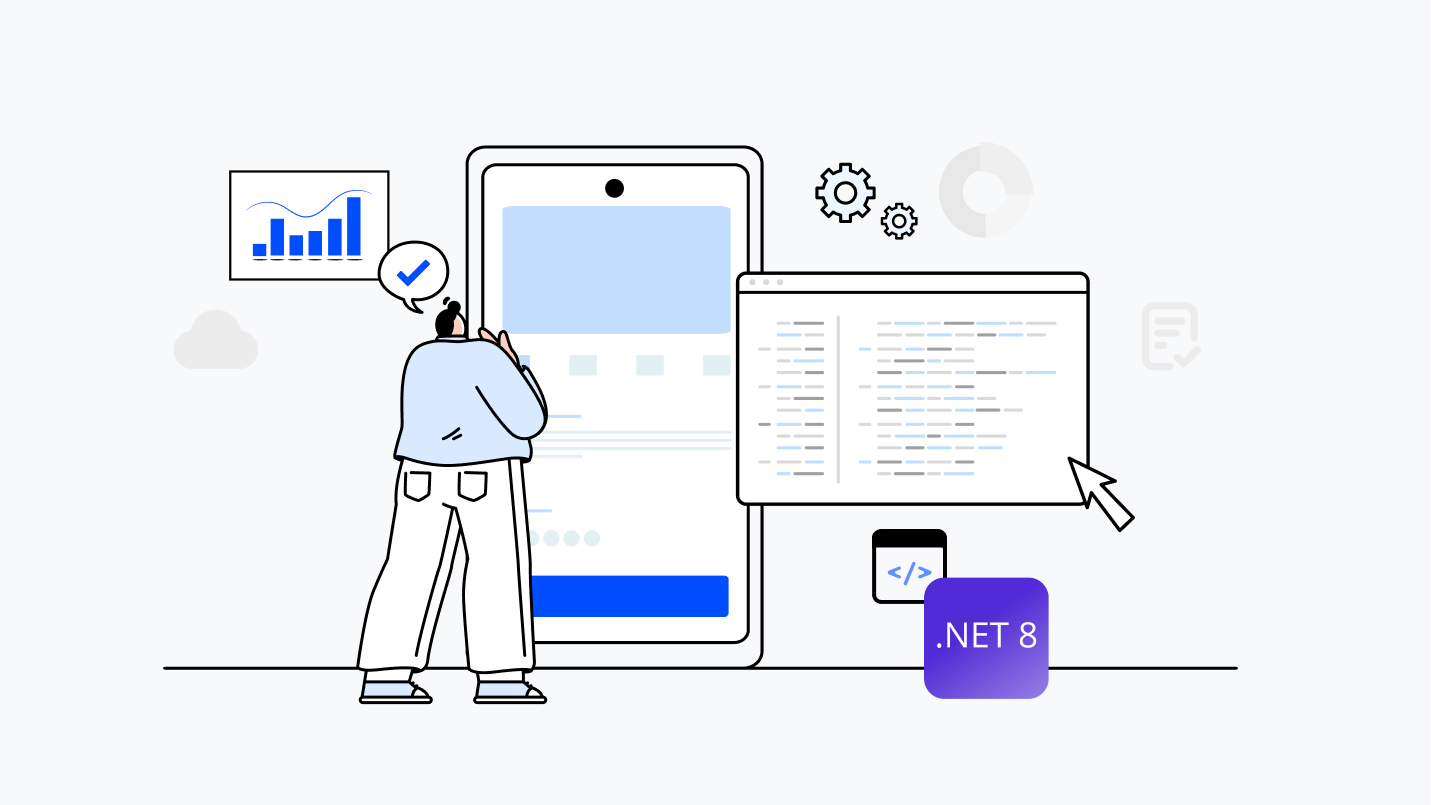Executive Summary
Net Solutions has helped several clients modernize critical business applications by migrating from the legacy .NET Framework 4.x to the cutting-edge .NET 8 platform. These strategic initiatives have transformed application ecosystems, supported cross-platform deployment, enhanced application performance and employee productivity, and positioned these systems for future scalability. Using proven AI-powered development tools like Cursor, an AI-powered code editor that automates code refactoring, provides intelligent dependency resolution, context-aware troubleshooting, knowledge augmentation, and ensures consistent pattern application, Net Solutions has significantly accelerated the modernization process while ensuring business continuity and the highest code standards.
Introduction
The .NET Framework and .NET are both Microsoft-supported implementations for building enterprise apps, but Microsoft now exclusively recommends the open-source and cross-platform .NET for development over the Windows-only .NET Framework.
Although .NET officially superseded the .NET Framework with the release of .NET 5 in 2020, many organizations continue to use legacy Framework versions (4.5.2, 4.6, and 4.6.1)—introducing security risks, performance bottlenecks, and technical debt. In this article, we will outline:
- Why legacy .NET is holding you back
- How we’ve applied AI to overcome those hurdles in 35% less time
- What .NET 8 delivers in terms of business value
- Our success stories
- The challenges during migration
- How to prepare for your migration
Why legacy .NET is holding you back
While Microsoft does not have plans to retire the .NET Framework, no new versions of the Framework will be released.
Relying on the legacy .NET Framework can contribute to security issues, performance issues, scalability and compatibility challenges, and unnecessary technical debt. Further, .NET Framework has limited cloud & container support, making it a bottleneck when shifting to the cloud. Put together, these challenges impact developer and employee productivity, ultimately undermining profitability.
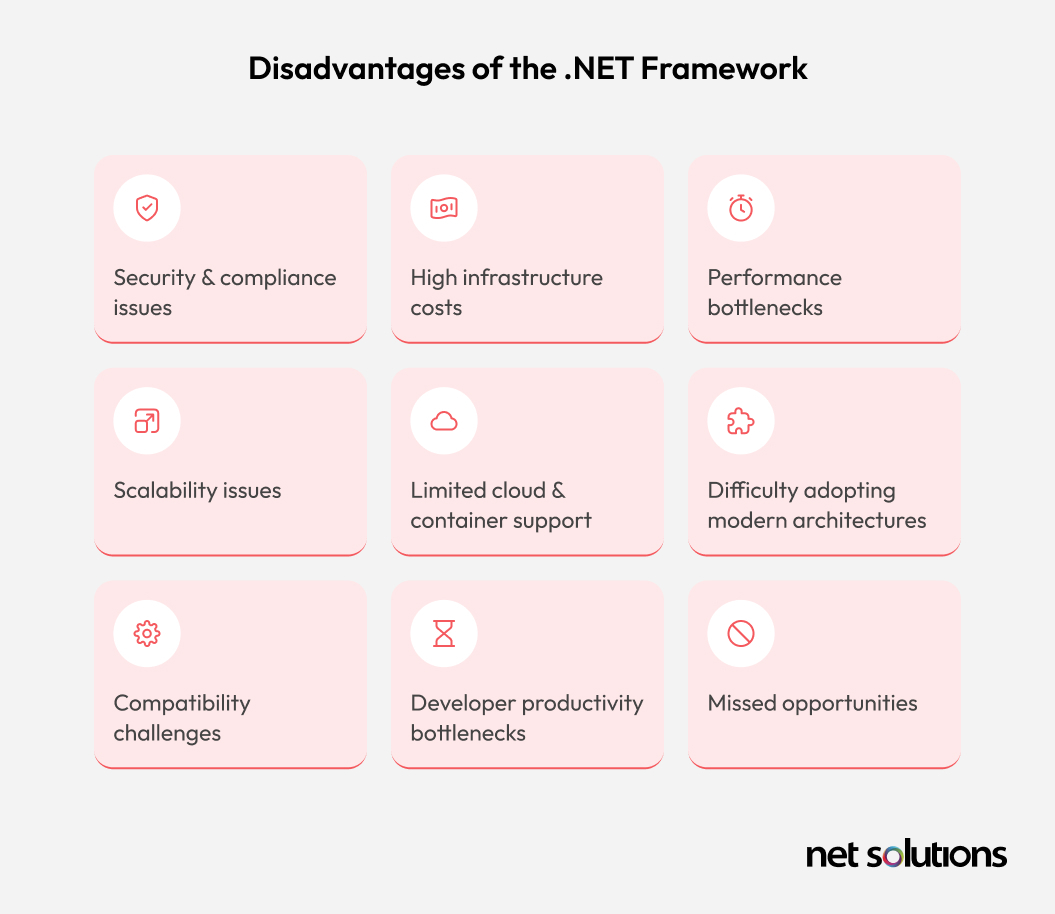
The reliance on legacy .NET Framework introduces an “innovation gap”—missed opportunities when you’re not leveraging modern .NET efficiencies.
AI-Powered Migration Acceleration
To demonstrate how AI can transform a migration, Net Solutions embedded Cursor AI—an advanced AI-powered code editor—directly into our development workflow. The result:
- 35% faster end-to-end migration with higher code quality and consistency.
Key Capabilities
- Automated Code Refactoring: Cursor’s AI capabilities helped identify and transform framework-specific code patterns to .NET 8 equivalents with minimal manual intervention
- Intelligent Dependency Resolution: The AI assistant quickly identified compatible package versions and suggested modern alternatives for deprecated libraries
- Context-Aware Troubleshooting: Reduced debugging time by providing intelligent suggestions for resolving migration-specific errors
- Knowledge Augmentation: Developers accessed contextual documentation and best practices without leaving their workflow
- Consistent Pattern Application: Ensured uniform implementation of dependency injection and configuration patterns across the codebase
Result: Incorporating Cursor AI yielded a 35% reduction in migration time while boosting consistency and enabling developers to focus on high-value architecture.
With that real-world acceleration front and center, let’s dive into The Business Benefits of .NET 8—from cross-platform reach to performance gains and cost efficiencies—that make it the ideal modernization target.
The Business Benefits of .NET 8
.NET (previously .NET Core) was designed to be a “build anything” platform, helping organizations meet the demand for apps that run on multiple platforms and in the cloud.
A LTS (long-term standard) of .NET is released every 3 years, with the latest being .NET 8. For organizations looking for stability in a .NET standard, porting from the .NET Framework to .NET 8 is the best choice.
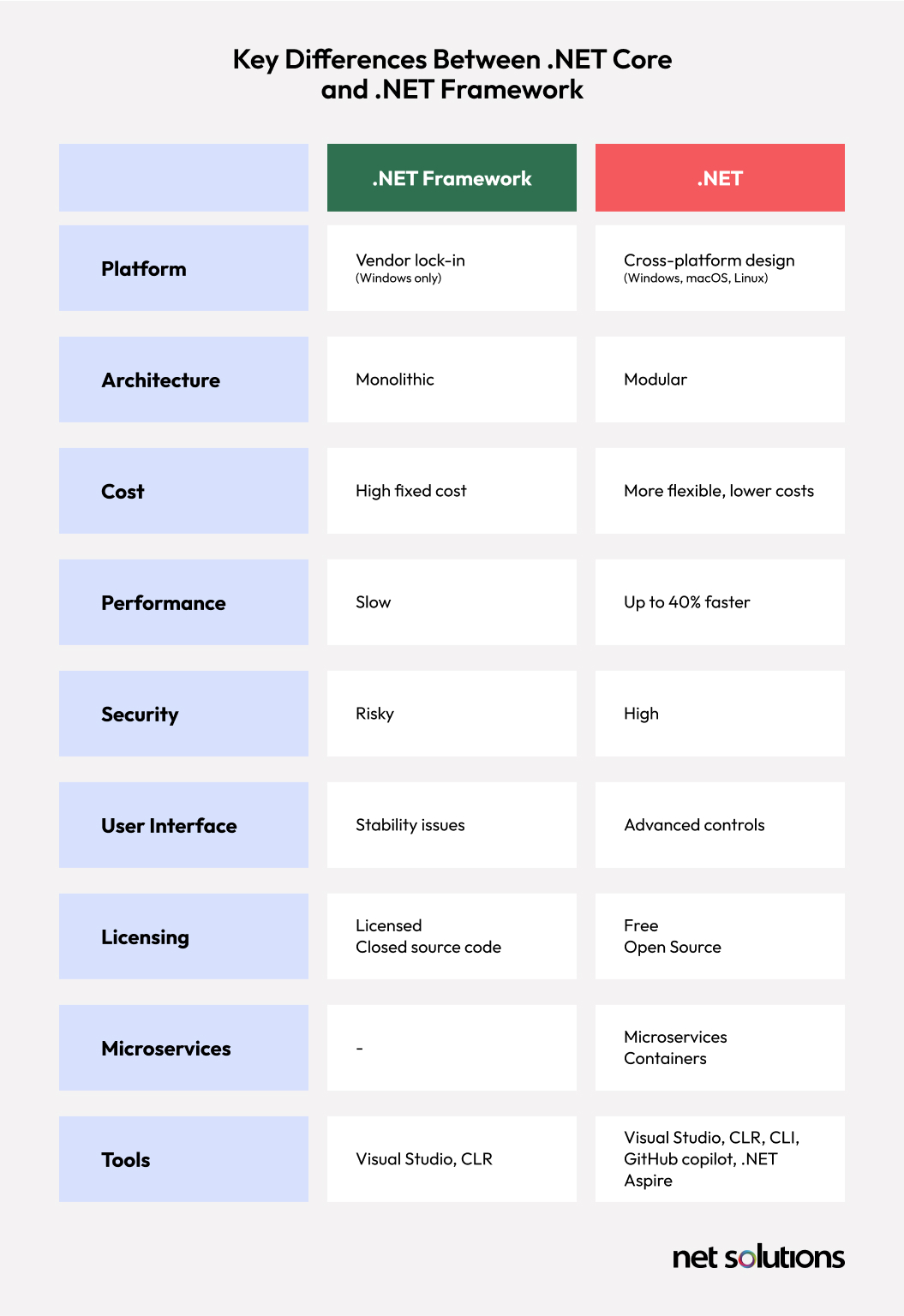
The following will outline some of the business advantages of .NET, with those benefits increasing with each new release.
1. Platform Independence
.NET is a robust cross-platform solution that helps meet the demand for enterprise apps that work across a wide range of devices and scenarios without having to write the code from scratch. The image below summarizes what you can build with the unified platform. The modularity in design allows developers greater control over runtime, libraries, and compilers. You could also build microservices-based applications using .NET (using ASP.NET and .NET libraries) and manage them with modern DevOps practices using containers (Docker, Kubernetes).
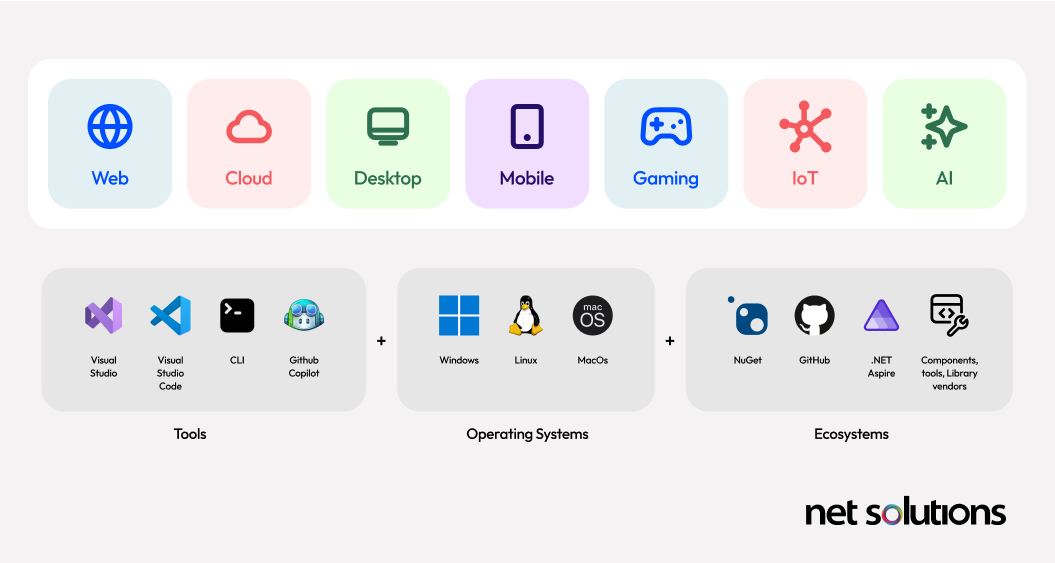
During modernization efforts, monolithic apps created with .NET Framework can be replatformed to use more nimble, cost effective and high performance microservices architecture.
2. Enhanced Performance
Enhanced performance is often the top business driver for migrating enterprise applications to .NET, as performance gains benefit employee productivity and operational costs.
.NET is objectively faster than the .NET Framework across a number of metrics, including CPU usage and response times, although the exact performance reduction will depend on the demands placed on your app and how well your app is optimized.
- More efficient runtime helps to speed up startup and execution
- Microservices support independent resource optimization and better fault tolerance
- Supports JIT (just-in-time) and AOT (ahead-of-time) compilation
- Significantly reduced memory footprint, including more efficient garbage collection
- Up to 40% faster request processing compared to .NET Framework
These performance gains continue to increase with each new version of .NET, with .NET 8 demonstrating a 24% improvement in requests per second over .NET 7.
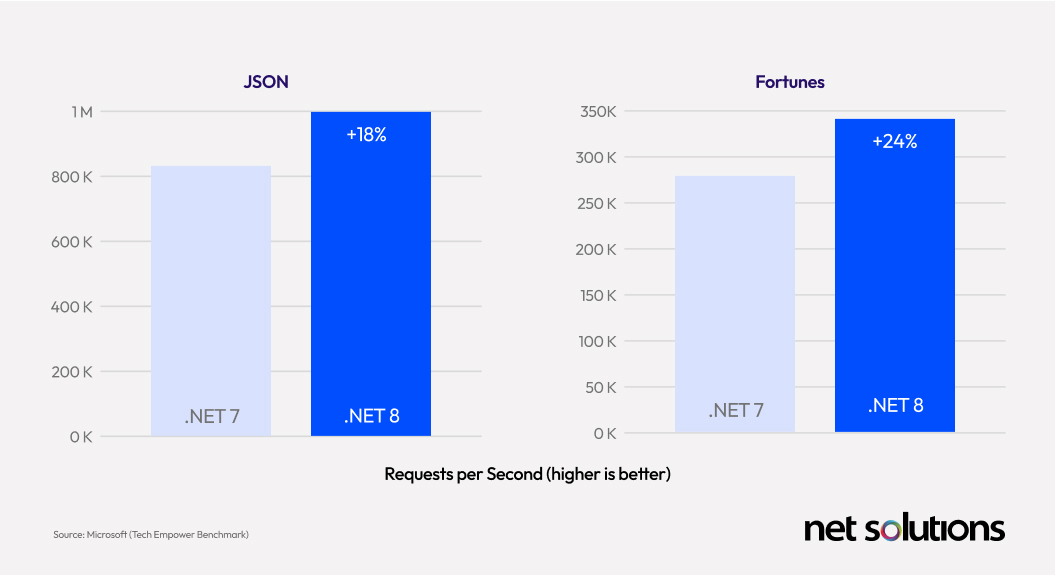
3. Cost Efficiency
While there is a cost to application modernization, including migrating from .NET Framework to .NET, there are a number of ways that you can recoup these costs and benefit from ongoing reductions in operating costs by migrating to .NET:
- Reduced infrastructure requirements through improved resource utilization (e.g. with ASP.NET, fewer servers or VMs are required)
- Deploying to Linux (instead of licensing Windows Servers) or cloud-native environments reduces operational costs
- Reduced development costs, through AI-assisted coding (e.g. GitHub Copilot) and microservices (modular deployments allow for faster updates and concurrent development opportunities)
- Reduced code changes when you choose a .NET version with LTS support (e.g. .NET 8)
4. Improved Security
While Microsoft continues to issue security patches for supported versions of the .NET Framework, there are a number of issues that could impact enterprise security and compliance.
- Unsupported versions: applications that rely on .NET Framework 4.5.2, 4.6 and 4.6.1 have been retired and are no longer secure.
- Modern security features that are missing in the .NET Framework are built into .NET (e.g. stronger authentication, encryption, compliance tools)
- Challenges with third-party integrations, including critical security and monitoring tools
- Compliance challenges arise when organizations lack basic security measures (e.g. MFA)
5. Future-Proofing
Built with cloud-first principles, .NET is easier to containerize, deploy and scale. Shifting to .NET ensures:
- Avoiding End of Life versions, which could leave businesses vulnerable to security risks and compliance issues
- Alignment with Microsoft’s long-term development roadmap
- Access to modern libraries
- Ongoing platform and tooling improvements, including the integration of artificial intelligence (AI) into .NET 8
- Access to the latest security features, not just patches
- Compatible with modern technologies, eliminating outdated .NET Framework dependencies that are a bottleneck with SaaS tools, AI/ML, or real-time analytics
- Simplified future upgrades through consistent release patterns
- Integration with modern AI development workflows such as GitHub Copilot, an AI-assisted coding tool
- Access to talent, as finding developers skilled in .NET Framework is becoming harder and the developer pool for .NET expands
Features of .NET 8
.NET 8 delivers significant improvements over previous versions, including performance improvements, out-of-the-box AI features to help integrate AI into your apps, container enhancements and .NET Aspire for cloud-native applications, and many other tools to support development.
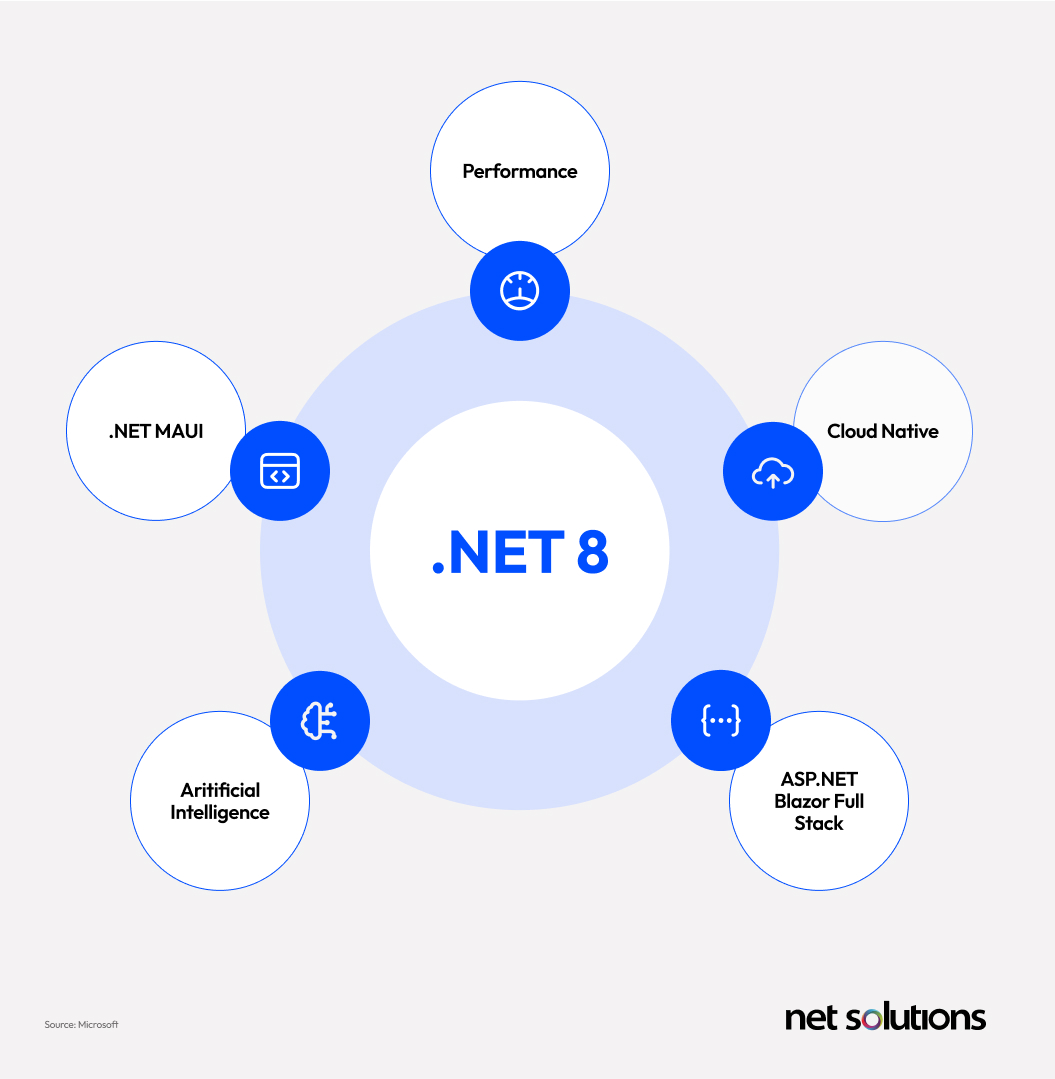
Although .NET 8 is a stable choice for modernizing existing enterprise applications, for enterprises who want to leverage a larger AI ecosystem in their apps (new apps or highly replatformed apps), we recommend a 2 phase development approach that leverages .NET 9 with a plan to transition to .NET 10 (LTS) when it is released. Once you have ported to .NET, upgrading .NET to newer versions is a very straightforward process.
Applications Ideal for Migration
Enterprise applications that currently have performance deficiencies or that need to be accessed on a variety of devices are ideal for migrating to .NET, including:
- Web Applications and APIs: Benefit from improved performance and cross-platform deployment
- Microservices: Take advantage of containerization and orchestration capabilities
- Background Processing Systems: Leverage improved reliability and monitoring
- Data Processing Applications: Utilize improved memory management and performance
- Enterprise Integration Services: Benefit from modern communication protocols and patterns
.NET Modernization: Our Success Stories
Net Solutions has over 20 years of experience in application modernization, helping enterprises realize the benefit of new technologies — such as .NET — while also ensuring applications are competitive and future-proof. In many instances, this means looking at the big picture to ensure we deliver the strategic top- and bottom-line results you’re looking for.
Future-proof your .NET apps with AI-driven intelligence and automation
Learn MoreWeb API Modernization
We worked with our client to successfully transform their legacy .NET Framework Web APIs to modern .NET 8 endpoints to meet the needs for performance, security, and scalability.

Modernizing background services
Enterprise applications commonly rely on background processing using the .NET Framework. Recently we helped several clients transition their background processing to .NET, including the transition of a complex scheduled job system from Windows-dependent to cross-platform using Hangfire.
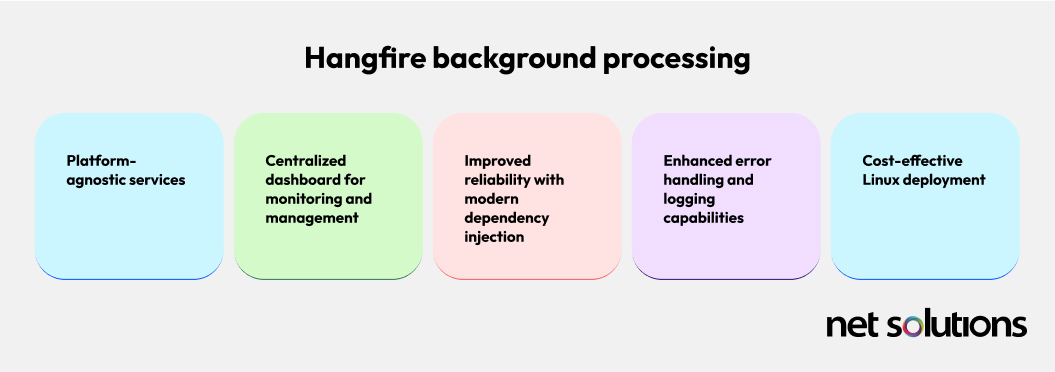
In another instance, we implemented a dedicated background processing using the .NET Worker Services template:
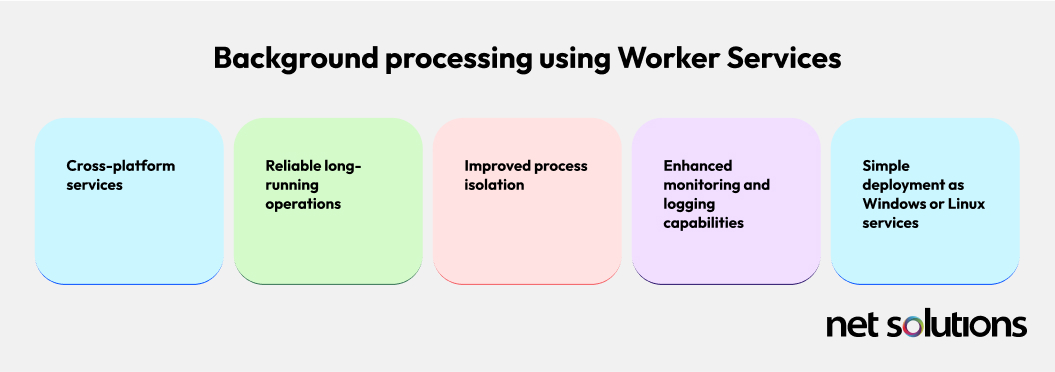
WCF Service Transformation
We helped our client migrate critical Windows Communication Foundation (WCF) services to CoreWCF on .NET 8 to enable cloud capabilities, modernize the development experience, and improve performance.

Optimized Linux Deployment
With another client, our application modernization efforts focused on improving operations by shifting from an expensive Windows environment to Linux.
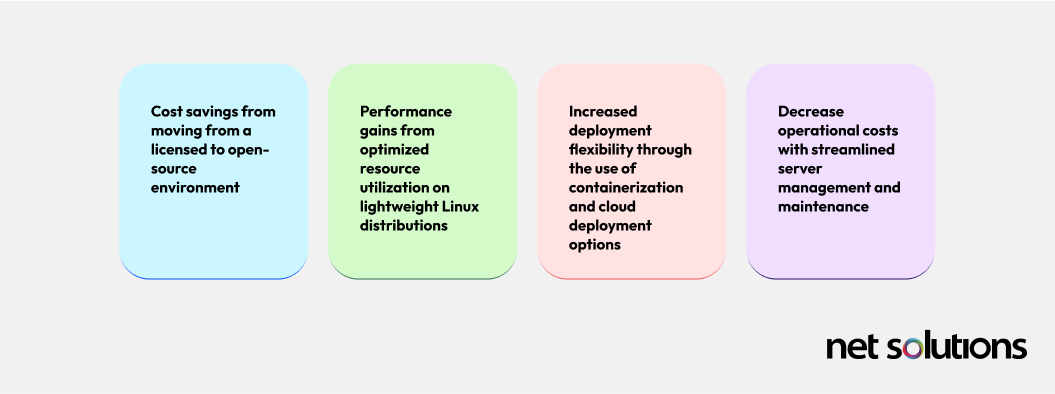
Potential Challenges with Migration
If moving from the .NET Framework to .NET was straightforward, we would not see the business we do. A poorly planned migration can break critical applications, leading to unexpected downtime, or could overlook the additional opportunities and efficiencies associated with a broader modernization effort that includes reviewing architecture, third-party integrations, and optimization.
Here are some of the challenges that in-house teams face when managing large-scale .NET migrations:
- A poorly planned migration can break critical applications, leading to downtime, lost revenue, and customer dissatisfaction.
- An in-house team focusing on migration gets pulled away from business-critical projects, impacting innovation and growth.
- Migration isn’t just about changing frameworks—it involves architecture redesign, dependency management, security reviews, and performance optimization. As an IT services firm, we have done this and seen multiple different scenarios which in-house teams may not have.
- Without proper expertise, companies might migrate the app as-is, missing out on cost savings and scalability benefits that comes with cloud-native architecture; a team that has managed legacy applications will not have the mindset needed or the expertise to architect a cloud-native architecture.
- Inexperienced teams may not recognize security vulnerabilities or will fail to meet compliance requirements (GDPR, HIPAA, etc.).
- In-house teams may lack the skills or experience with .NET tools, including ASP.NET core and .NET Runtime, leading to more costly and time consuming migrations, regressive and compatibility issues, or missed opportunities (e.g. AI-assisted coding).
At Net Solutions, we care about your success and are dedicated to helping you navigate modernization growth opportunities with an eye to minimizing disruption. We start every interaction with a deep dive into your infrastructure, code and business requirements to help you create future-proof enterprise solutions.
In the next section, we will detail how we work with clients to overcome these challenges and prepare for a successful .NET migration.
How to Successfully Prepare for Your .NET Migration
Once you decide to upgrade to .NET, it’s critical to take the time to evaluate your infrastructure and plan out the scope of your project. Planning is the key to transformational outcomes.
Planning examines where you are and where you want to be—looking beyond the .NET migration. This stage of planning will:
- Evaluate application complexity, platform-specific code, and dependencies
- Run an audit to identify current deficiencies and opportunities to improve during modernization
- Review architecture, security, and performance optimizations (e.g., lazy loading, composite indexes, streamlined query execution plans)
- Identify .NET Framework-specific features, third-party libraries, or NuGet packages requiring alternatives
- Create a detailed migration roadmap with prioritized components
- Set up AI-assisted development environments
- Incorporate AI-powered development tools early in the process
- Train teams on the effective use of AI development assistants
- Use AI tools like Cursor for code suggestions and rapid prototyping
- Implement pair programming with AI assistants for knowledge transfer
- Leverage AI for identifying potential issues in migrated code
- Maintain consistent coding standards with AI-powered linting and reviews
- Use AI to generate unit tests for critical functionality
If you go to RFP for your .NET migration and you don’t see formalized planning or an assessment for the need to modernize architecture (beyond .NET), this is a red flag that a company is not looking out for your best interests.
The most successful modernization efforts begin with a new project structure rather than attempting to “convert” existing projects, a process that moves existing deficiencies to a higher performing framework. These efforts will look to embrace modern architectures (e.g., microservices), programming patterns, improve the code structure, adopt modern security and authentication protocols, set up CI/CD pipelines to support multi-platform deployment, and integrate AI tools to support development workflows and reduce OpEx.
Alongside technical improvements, it is critical to take the time to plan for and document operational procedures for the new environment and new processes, including areas such as logging, monitoring, maintenance, performance optimization, and security.
Net Solutions Delivers Accelerated Migration and Future-Ready Results
Migrating to .NET 8 represents a strategic investment in application infrastructure, delivering immediate benefits while positioning clients for future growth. The cross-platform capabilities, performance improvements, and modern development patterns available in .NET 8 have transformed the application ecosystems of our clients – across industries and enterprise size – providing a solid foundation for innovation.
Net Solutions is proud to offer 360° migration acceleration, lending our experience to modernization efforts from planning through to execution and beyond. With our deep migration expertise and the help of AI accelerants, Net Solutions is able to deliver on .NET migrations and full modernization projects in a fraction of the time (more than 35%) and cost of an internal team, while also ensuring code quality and a lowered risk of downtime.
At Net Solutions, partnership is more than just a word – it’s a commitment. We are dedicated to helping you navigate the complexities of enterprise app modernization, helping our clients accelerate the .NET migration process and future-proof their business with modern technologies and optimized processes, providing immediate OpEx and CapEx savings.


